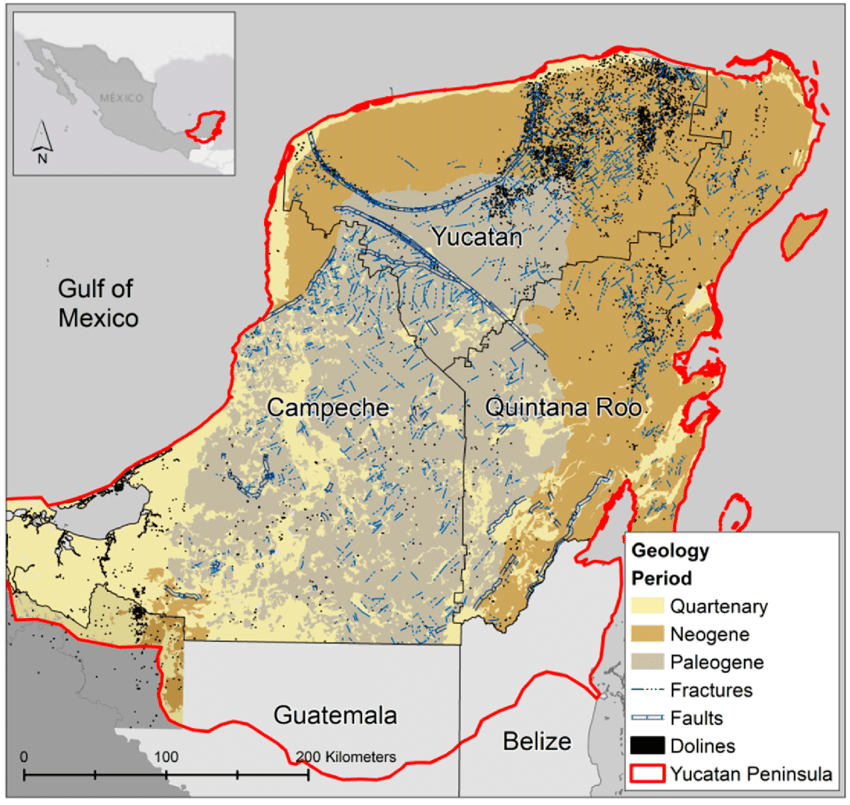Cenotes
Natural Wonders of Mexico’s Yucatan Peninsula
WHAT IS A CENOTE?
The Yucatan peninsula separates the Caribbean Sea from the Gulf of Mexico. It is a relatively flat platform composed of limestone rock with no surface rivers or streams.
The Yucatan peninsula has been emerging from the sea gradually and has been exposed to the sea level variation during the ice ages (last two million years) up to 130 meters (430 feet).
The earth was hit by a 10 kilometer (6 miles) size asteroid in the shallow sea area of the Yucatan continental platform 65 million years ago. The result was the Chicxulub impact crater (also referred to as the Ring of Cenotes), which is 200 kilometers (124 miles) in diameter (about half offshore and half on-land) and lies 1 km (0.6 mile) below the ground surface, covered by deposits of limestone rocks. The asteroid is considered to be the reason that caused the extinction of the dinosaurs.

Origin and Formation of Cenotes and Caves
A “cenote” (pronounced say-NO-tay) is a natural sinkhole created where a cave ceiling has collapsed, opening a window to this spectacular world. Cenotes were the only source of water in the jungle for the Mayan civilization and are considered sacred by the Mayan people. The Mayan consider cenotes to be an entrance to their “underworld” or “Xibalba” where their gods live and their spirits reside after death.
The word cenote is derived from the Mayan word “D’zonot” and refers to any subterranean chamber that contains permanent water. While some cenotes are vertical, water-filled shafts, others are caves that contain pools and underwater passageways in their interior.
A combination of geologic events and climatic change has led to the development of these unique ecosystems. Millions of years ago, the Yucatan peninsula was a giant reef set under several feet of ocean water. During the ice ages, the ocean level dropped (water levels were approximately 130m (430ft) lower than their present-day levels), exposing the reef to the surface. The coral died, and jungle grew over the mile thick limestone platform created by the coral reef. Fossils found far inland are proof of this and are commonly seen during a cenote dive.
Dissolution Caves
Massive cave systems were formed by gradual dissolving of the highly porous coral limestone. These caves are called “solution” (or better dissolution) caves because they were formed by the slightly acidic rainfall dissolving the alkaline limestone.
In addition, the low altitude of the area causes the mixture of fresh and salt water, which increases the dissolution of the rock and it is considered the most powerful dissolution process.
Cenote Collapses and Construction
When the sea level went down due to the ice ages, the aquifer level fell as well leaving behind a cavity or cave filled with air. Some sections of the rock roof collapsed due to a lack of strength, forming a cenote. Cenotes are the windows formed in the caves to the outside. At the end of the ice age the sea returned and the water flooded the caves.
However, inside the caves, while they were dry, the rain was filtered and dragged minerals along, forming stalactites (which hang like icicles from the cave’s ceiling), stalagmites (which extend upwards from the cave floor), and columns (when stalactites and stalagmites join together). These stalactites and stalagmites number in the millions and range in size from that of a pencil to the size of a big tree. These formations, unfortunately, stopped growing once the sea level rose.
Many of the cave roofs eventually collapsed and when the last Ice Age came to a close about 12,000 years ago, the climate of the planet warmed up, the glaciers receded, and the caves flooded as sea levels rose. Scientists have varying views on how fast water levels rose, but most agree that the water reached its current level around 3,000 years ago.

The Life Inside Cenotes
Among the interesting archaeological finds in recent years are ancient fossilized remains of camels, giant jaguars, mammoths, sloths, and horses. To date, ten human skeletons have been found. One of them is of a 25- to 30-year-old human female named “Eve of Naharon.” The skeleton is carbon dated to 13,721 years ago which makes it the oldest human skeleton found in the Americas. Most of these have been found by cave divers exploring underwater cave systems and some sites are now protected by INAH (Instituto Nacional de Antropologia e Historia), the Mexican government’s archaeological and historical protection organization.
When visiting the cenotes...
When visiting the cenotes, please consider yourself a guest and act accordingly. We must show respect and be careful while diving underwater and walking around on the land’s surface, particularly near a dive site. The fragile biological life, formations, and archaeological history are there for the divers’ interpretation and enjoyment. Divers should leave the cenote the exact way they find it.
That’s why, take only memories, kill only time, and leave nothing behind, but bubbles!!
